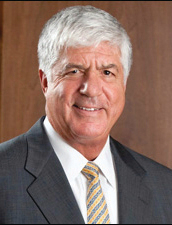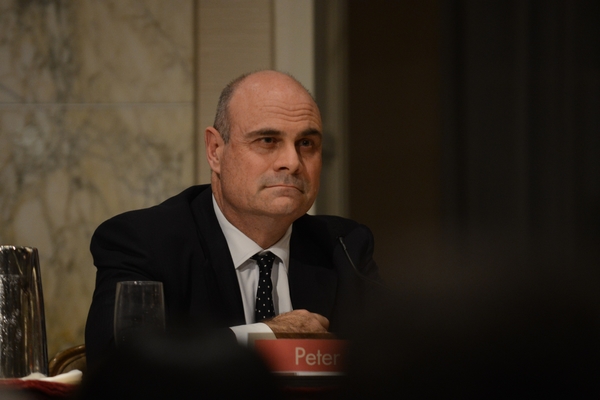
American International Group President and CEO Robert Benmosche got a bit sentimental about the company’s post-financial crisis turnaround during his last investor earnings call on Aug. 5. He also formally passed the torch to his replacement, who pledged to keep many of the policies and strategies currently in place.
Right at the start, AIG’s 2014 second-quarter earnings call amounted to a victory lap and farewell reflection for its departing leader.
Benmosche took over the company’s stewardship five years ago, in the depth of the financial crisis that nearly crushed the insurance conglomerate. Under his leadership, AIG fully paid back a $182 billion government bailout it accepted in 2008, plus profit. Benmosche also worked with his executives to craft a long-term strategy that included divesting noncore assets, streamlining its global operations with a cleaner management structure and growing more smartly than it had in the past.
His replacement, as of Sept. 1, is Peter Hancock, who has served as CEO of AIG Property Casualty and as an executive vice president. Hancock has stated, and continues to insist, that he’ll generally stay the course that Benmosche has set.
Benmosche acknowledged AIG’s turnaround but gave collective credit during his final investor call as CEO for the gains he is leaving behind.
“I appreciate being with all of you,” he said. “It has been a five-year period of a lot of excitement. This quarter reflects a lot of hard work on behalf of a lot of people at AIG.”
Reflecting on the broader turnaround since the financial crash, Benmosche noted to his team that “you all had a daunting task of stabilizing this company and paying back America” following the bailout.
“We’ve done that with a profit,” he said.
Benmosche said that AIG rebuilt its foundation “the right way,” reflected by its “solid” performance in the 2014 second quarter. The company’s net income rose to $3.07 billion, or $2.10 per share, up from $2.73 billion, or $1.84 per share, in the 2013 second quarter. Commercial underwriting net premiums earned rose 4 percent to $5.27 billion, and the combined ratio came in at 95.4, up from 101.7 a year ago. Consumer underwriting net premiums earned dipped slightly to $3.25 bllion, with the combined ratio coming in at 100.1, up from 98 in the 2013 second quarter.
Those numbers, which exceeded analysts’ expectations, reflect AIG’s progress since nearly collapsing in the midst of the financial crisis, Benmosche said.
“We talked about making sure we execute our capital plan, [which] started out with selling noncore assets, which we have achieved. We have also been able to repurchase and continue to repurchase our shares,” Benmosche said. “But we said to you also that in addition to dividends and share buybacks it is important we focus on the coverage ratio.”
He said that investors and executives can “see strong results across all of our businesses” and that the property/casualty arm “has been working very hard toward getting it right, value over volume, and that takes a lot of time.”
With that, Benmosche talked about succession, noting that AIG had “a strong” bench of potential CEO successors. He said he was pleased that Hancock is taking over, noting his many years of previous executive experience.
Hancock “spent the last three years really getting into the nuts and bolts of the property/casualty business using risk data,” Benmosche said. “He’s done an outstanding job, and I know he will do an outstanding job in the future.”
Hancock then stepped up to speak during the call, initially gushing about Benmosche’s impact.
“I would like to thank Bob for the remarkable leadership he has shown over the last five years. The employees, company and U.S. taxpayers owe him enormous thanks for the contributions he has made,” Hancock said. “His leadership is awesome to follow. And I shall do my very best to continue the legacy of this company.”
Hancock said during the call that “there will be no abrupt change in strategy,” adding that “clearly this is a vote for continuity. We are on the right track, and we’re in execution mode.”
Like Benmosche, he said that he is committed to growing business value “rather than simply bulking up the company.”
As well, Hancock said, he won’t replace himself as head of AIG’s property/casualty arm. Instead, he noted that the heads of AIG’s consumer and commercial segments “have assumed broader strategic leadership that those two very large segments deserve.” Beyond that, he said he wants to make “the whole company flatter in the hierarchy” and “minimize layers in management between the CEO and the trenches to improve our responses to customers and the market.”
While Hancock promised to stay the course for now in terms of strategy, he said there will be changes “as the opportunities arise,” but nothing radical.
Benmosche “and I have been highly aligned on strategy over the last four years,” Hancock said. “The team as a whole has really coalesced around our current strategy and is in execution mode. The changes in strategy will largely be refinements in execution.”
Hancock acknowledged some “headwinds” in pricing in the U.S. property catastrophe coverage, but he said that focusing on diversifying AIG’s book of business has helped it become better equipped to handle softness as it hits.
“We have been diversifying away from U.S. property [catastrophe] for the past five years and diversifying our property exposure,” Hancock said. “Around the world, we’ve diminished our exposure to that portion that’s a cyclical phenomenon.”
“We are much better equipped to deal with the inevitable cyclicality of the pricing environment and have tremendous diversity of pricing and lines so we can redeploy capital in a customer-friendly way to maintain customer relationships,” Hancock said.
Still, fallout continues from AIG’s financial meltdown in 2008 over bad derivative investments. Separately, AIG disclosed in an Aug. 4 regulatory filing that it would pay $960 million to settle securities litigation relating to statements it made before the 2008 U.S. government bailout. A court must still approve the deal, according to the filing.





















 Breaking: Andersen to Replace Zaffino as CEO of AIG on June 1
Breaking: Andersen to Replace Zaffino as CEO of AIG on June 1  Why the Middle Market Matters and How Insurers Can Capture It
Why the Middle Market Matters and How Insurers Can Capture It  Executives on the Move at Liberty Mutual, Cowbell, W. R. Berkley
Executives on the Move at Liberty Mutual, Cowbell, W. R. Berkley  Good Times for U.S. P/C Insurers May Not Last; Auto Challenges Ahead
Good Times for U.S. P/C Insurers May Not Last; Auto Challenges Ahead 








